Urban Land Pattern Impacts on Floods in a New District of China
Abstract
:1. Introduction
2. Methods and Data
2.1. Study Area and Urban Land Use Types
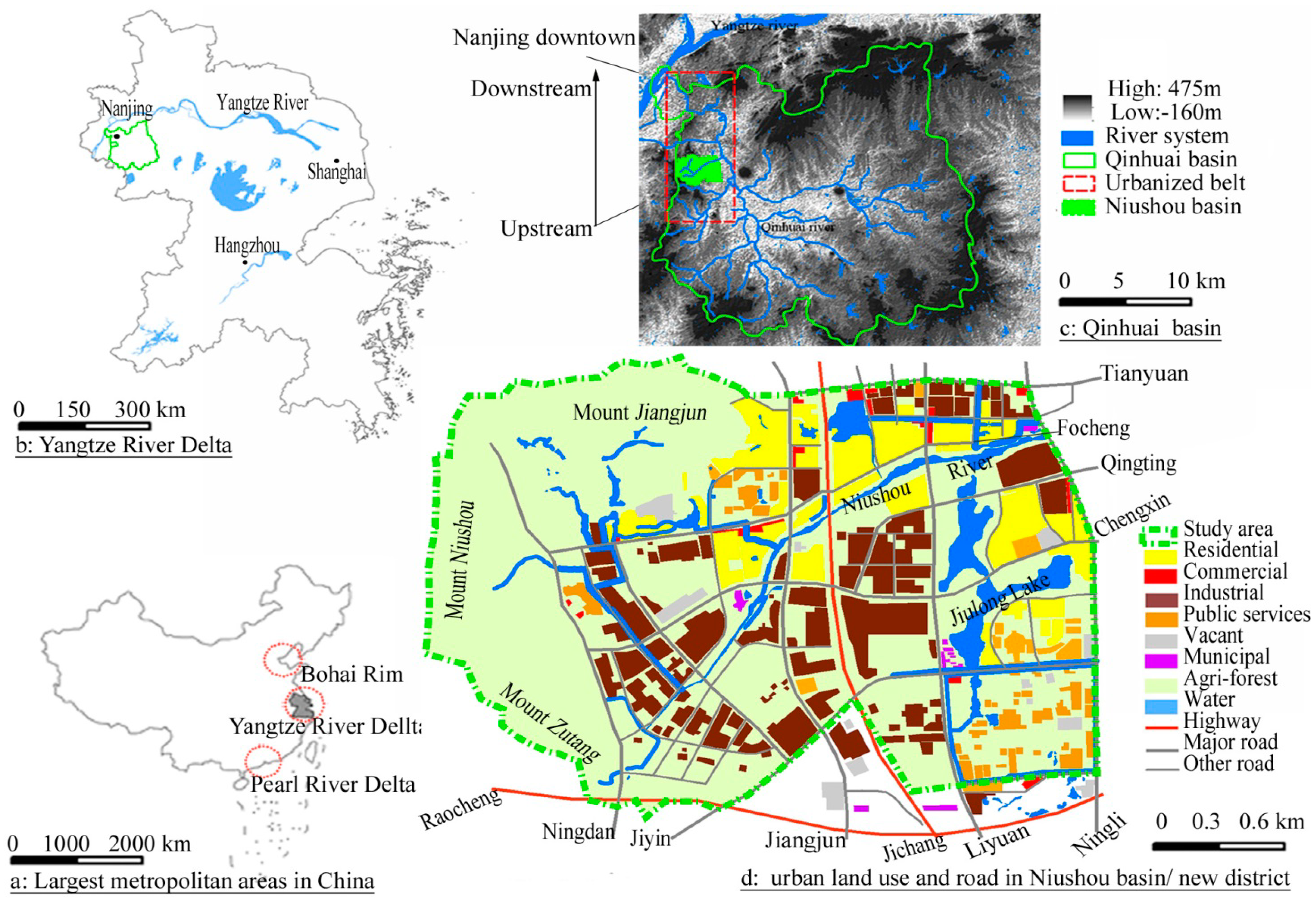
2.2. Urban Zones and Drainage System
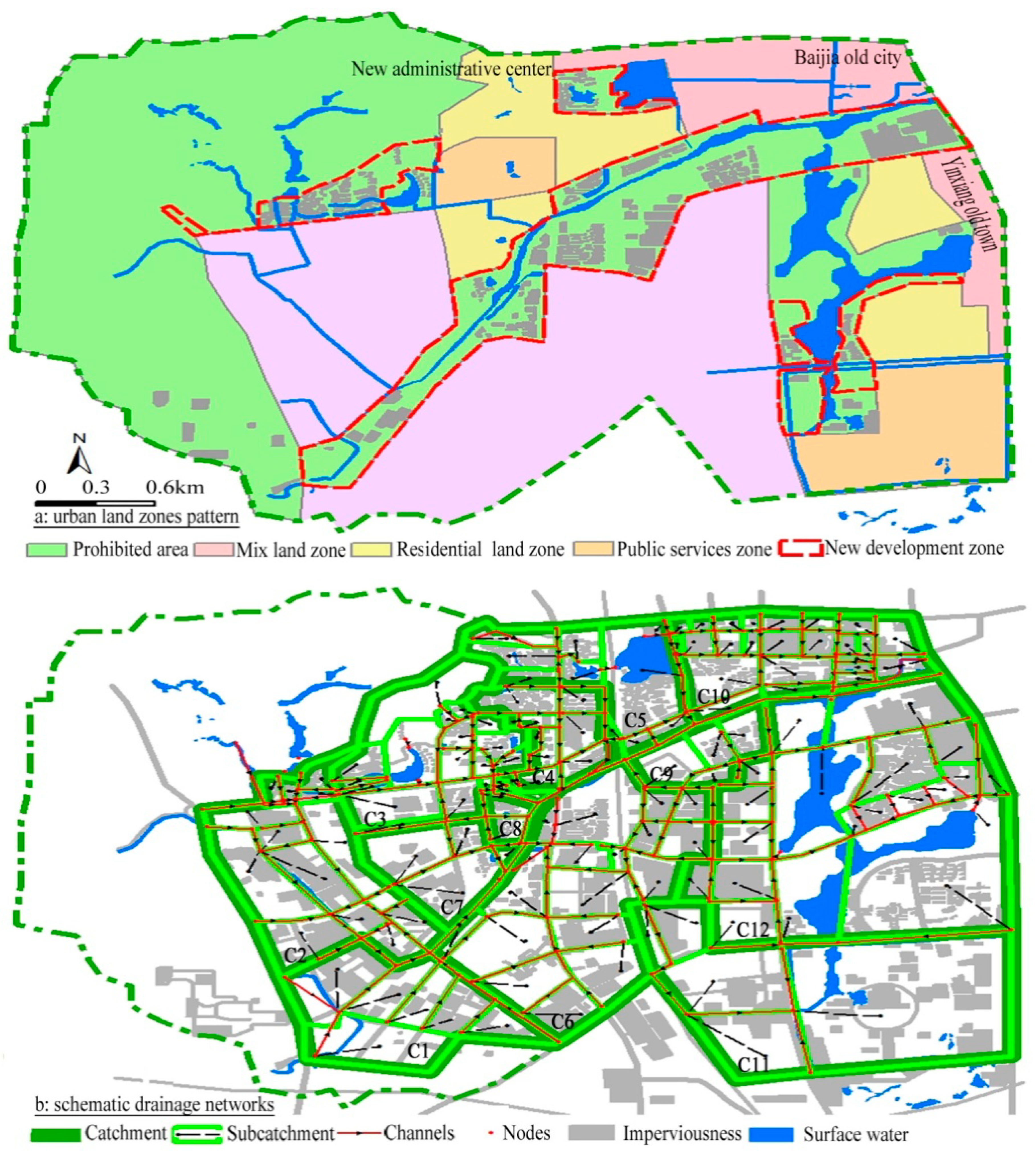
- The CP drainage lines against natural flow lines fall into four categories of patterns (Figure 3a). The CP1 lies in the belts adjacent to the downstream Niushou River dams, where the roads parallel to the river absorb massive floodwaters and even make floodwaters back flow into adjacent residential lots. The CP2 lies in the downstream lowlands with indistinct flow routes, easily leading to floods. The CP3 lies in the upstream, uneven topographic areas. The CP4 results from the cut of natural flow lines between different urban land zones only connecting own pipes with the municipal lines.
- The CFP drainage lines mostly following natural flow lines fall into two categories of patterns. One is a parallel-type pattern with the main channel parallel to the contours in catchment, such as the C2, C4, C7, C9, where the main channels are commonly at intersections between different natural catchments and regarded as the flood intercepting trenches to absorb floodwaters from upstream rapid flow-rate sub-channels into the receiving water (Figure 3b). In addition, the belts along the slow flow channel with many lowlands adopt flooding measures, such as flyovers, pumps, and elevated works. The other is an orthogonal-type pattern with the main drainage channel perpendicular to the contours in the catchment, where urban zones are commonly located at hillsides or are elevated through work (Figure 3c). Roads and channels are the rapid flood passages and have the greatest floods pressures at their outlets.
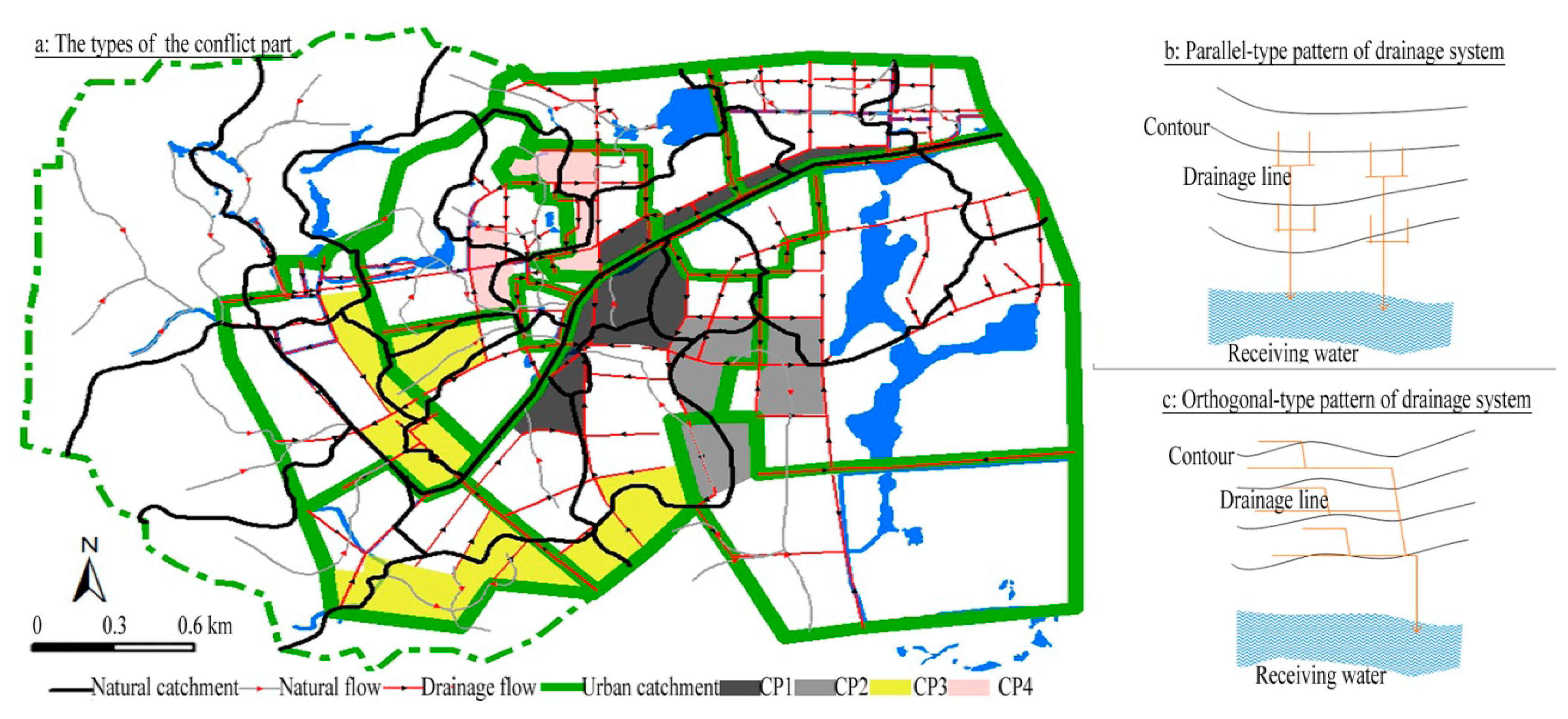
2.3. Urban Land Pattern Metrics in Terms of Urban Floods
- Each catchment falls into three parts, i.e., downstream, middle, upstream, by the main stem of the channel/stream, and is estimated the clustering degree of imperviousness in vertical dimension (parallel to the main stem of the channel/stream) (CL-V) via Equation (1), where Xi for area percentage of imperviousness in each part (e.g., upstream) and X for average area percentage of imperviousness over the catchment. The CL-V equals 0 when imperviousness is maximally disaggregated in three parts, and increases as imperviousness is increasingly aggregated in some parts.CL-V = 100[∑(Xi − X)2/3]0.5
- Each catchment falls into two parts, i.e., adjacent and non-adjacent, by the main channel buffer with its radius, r, based on the mean size of all subcatchments S, i.e., r = S0.5 = 42.01 m, and is assessed the clustering degree of imperviousness in horizontal dimension (orthogonal to the main channel) (CL-H) via Equation (2), where Xi for area percentage of imperviousness in each part (e.g., adjacent) and X for average area percentage of imperviousness in two parts. The CL-H equals 0 when imperviousness is maximally disaggregated in two parts, and increases as imperviousness is increasingly aggregated in the adjacent part.CL-H = 100[∑(Xi − X)2/3]0.5
- Each catchment falls into four parts by elevation breaks of 4 m, 13 m, and 22 m based on ArcGIS. Firstly, the surfaces ≤13 m and surfaces >13 m are defined as lowlands (L) and hillsides (H), respectively. Secondly, according to the area ratio of lowlands and hillsides in the catchment, each catchment falls into three categories, such as L%, H%, LHr, where L% is regarded as a low-elevation-led catchment with its lowlands area ratio of over 80% (e.g., L85 means that the area ratio of lowlands in the catchment is 85%) and, moreover, the H% referring to a high-elevation-led catchment with hillsides area ratio of over 80%. However, if both L% and H% are less than 80% in the catchment, LHr means that there is not an obvious leading elevation area, where r is the ratio of hillsides area to lowlands area in the catchment. Lastly, which elevation area does the imperviousness incline to move to? The I-E-D (Imperviousness elevation distribution) is calculated by subtracting the actual ratio of imperviousness in the catchment from its lowlands area ratio (m shows the subtractive value) to measure the elevation characteristics of imperviousness pattern: The I-E-D is greater than 1 and labeled as L-m when the imperviousness is maximally disaggregated in lowlands in the catchment, and increases as the imperviousness is increasingly aggregated in lowlands; The I-E-D is less than −1 and labeled as H-(-m) when the imperviousness is maximally disaggregated in hillsides in the catchment, and increases as the imperviousness is increasingly aggregated in hillsides; If the I-E-D is between −1 and 1 and labeled as 0, the imperviousness spatial feature corresponds to states of the catchment elevation by the leading DEM.
2.4. Effects of Patterns of IR on Flooding Based on Modeling Runs
3. Results
3.1. Urban Land Use Pattern Characteristics
3.1.1. Imperviousness Ratio
| IR [%] | 24.22 | 32.05 | 40.43 | 24.25 | 24.95 | 51.21 | 32.09 | 22.50 | 35.17 | 24.84 | 80.59 | 45.16 |
| CL-V [-] | 28.7 | 24.9 | 23.6 | 20.86 | 17 | 8.96 | 8.282 | 4.472 | 4.472 | 2.78 | 1.41 | 1.25 |
| CL-H [-] | 50 | 30 | 20 | 22 | 35 | 10 | 16 | 35 | 5 | 10 | 7.52 | 5.32 |
| Mean DEM [m] | 7.1 | 5.7 | 12.3 | 13.7 | 9.9 | 9.6 | 10.8 | 19.7 | 13.3 | 7.1 | 5.3 | 10.8 |
| Leading DEM [m] | L95.8 | L96.7 | LH1.34 | LH1.53 | L82 | L92.7 | LH1.99 | H87.9 | LH1.87 | L96.7 | L100 | LH1.97 |
| I-E-D [-] | 0 | H-2.4 | 0 | L-10.2 | L-3.3 | H-3.9 | L-5.8 | L-6.6 | L-3.5 | 0 | 0 | 0 |
| Pattern types | CC | MP | H-CL | MP | CC | H-CU | MP | CC | L-CU | L-CU | H-CU | H-CU |
| 1985 water ratio [%] | 10.81 | 20.87 | 15.84 | 12.13 | 19.26 | 3.39 | 10.36 | 9.95 | 24.37 | 18.25 | 25.46 | 11.09 |
| 2010 water ratio [%] | 10.34 | 15.13 | 15.58 | 3.55 | 4.96 | 2.45 | 1.46 | 0.73 | 0.33 | 2.02 | 14.43 | 2.72 |
| Channel density [km/km2] | 2.10 | 2.61 | 3.69 | 3.73 | 2.99 | 5.42 | 3.09 | 3.15 | 3.55 | 1.36 | 8.97 | 5.85 |
| Main types | Resi | Mix | Resi | Resi/indus | Indus | Mix | Resi/indus | Indus | Indus | Public | Resi | Mix |
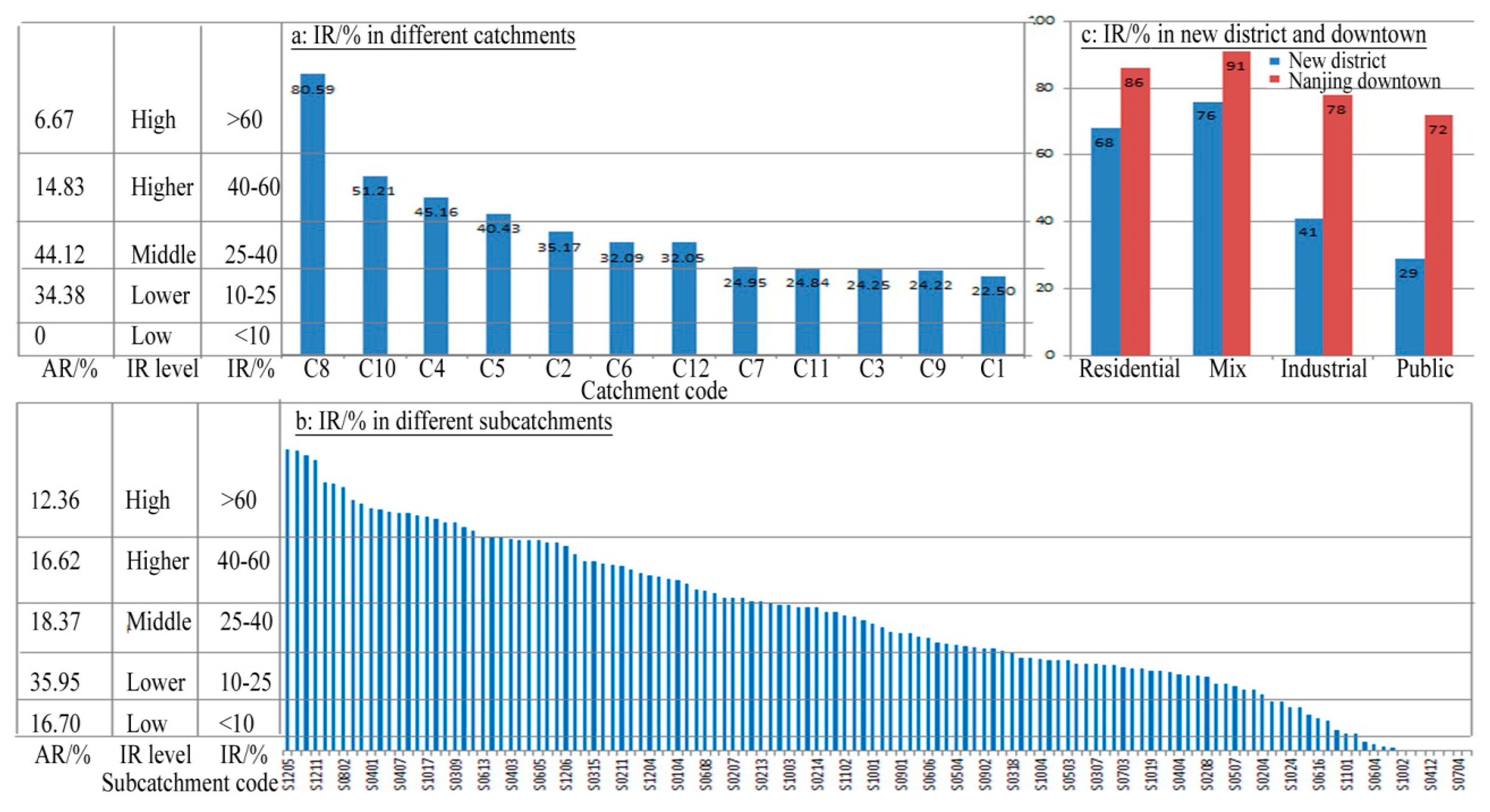
3.1.2. Imperviousness Pattern
| Pattern types | H-CU | H-CL | L-CU | MP | CC |
|---|---|---|---|---|---|
| IR | High | Higher | Low-middle | Higher | Low-middle-high |
| CL-V | Low | High | Low | Low-middle-high | Low-middle-high |
| CL-H | Low | Middle | Low | Low-middle-high | High |
| Land-led types | Mix-Resi. | Resi. | Resi.-public | Unused-water | Resi-indus. |
| Catchment | C8, C10, C4 | C5 | C11, C2 | C3, C6, C12 | C1, C7, C9 |
3.2. Effects of Patterns of IR on Flooding Based on SWMM

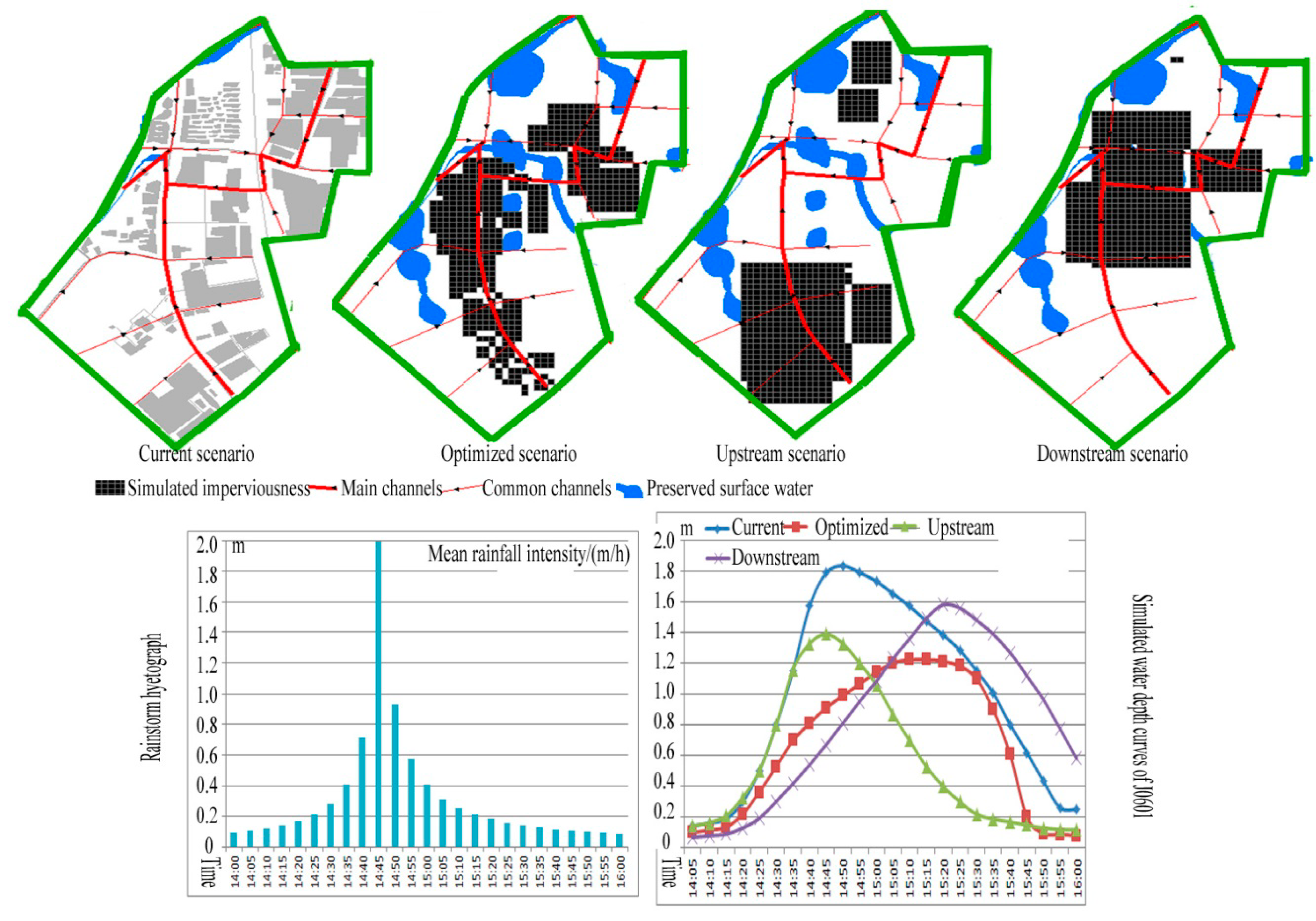
| Catchment | The catchment C4 | The catchment C6 | ||||
|---|---|---|---|---|---|---|
| Time\Scenarios | Current | Optimized | Current | Optimized | Upstream | Downstream |
| 14:05 | 0.20 | 0.07 | 0.14 | 0.10 | 0.14 | 0.07 |
| 14:10 | 0.22 | 0.08 | 0.16 | 0.12 | 0.17 | 0.08 |
| 14:15 | 0.24 | 0.09 | 0.19 | 0.14 | 0.21 | 0.09 |
| 14:20 | 0.31 | 0.12 | 0.30 | 0.22 | 0.33 | 0.13 |
| 14:25 | 0.46 | 0.22 | 0.50 | 0.36 | 0.50 | 0.19 |
| 14:30 | 0.63 | 0.32 | 0.80 | 0.53 | 0.80 | 0.30 |
| 14:35 | 0.80 | 0.43 | 1.15 | 0.70 | 1.16 | 0.42 |
| 14:40 | 0.99 | 0.55 | 1.57 | 0.81 | 1.33 | 0.54 |
| 14:45 | 1.14 | 0.74 | 1.79 | 0.91 | 1.39 | 0.67 |
| 14:50 | 1.24 | 0.93 | 1.83 | 0.99 | 1.33 | 0.81 |
| 14:55 | 1.30 | 1.08 | 1.79 | 1.07 | 1.20 | 0.96 |
| 15:00 | 1.33 | 1.13 | 1.73 | 1.14 | 1.06 | 1.09 |
| 15:05 | 1.36 | 1.00 | 1.65 | 1.20 | 0.87 | 1.23 |
| 15:10 | 1.35 | 0.81 | 1.57 | 1.22 | 0.70 | 1.36 |
| 15:15 | 1.34 | 0.67 | 1.48 | 1.22 | 0.53 | 1.49 |
| 15:20 | 1.31 | 0.55 | 1.38 | 1.21 | 0.40 | 1.58 |
| 15:25 | 1.27 | 0.45 | 1.28 | 1.18 | 0.30 | 1.56 |
| 15:30 | 1.20 | 0.36 | 1.15 | 1.10 | 0.22 | 1.48 |
| 15:35 | 1.06 | 0.31 | 1.01 | 0.90 | 0.19 | 1.39 |
| 15:40 | 0.81 | 0.26 | 0.81 | 0.61 | 0.17 | 1.27 |
| 15:45 | 0.60 | 0.22 | 0.62 | 0.20 | 0.15 | 1.12 |
| 15:50 | 0.49 | 0.18 | 0.43 | 0.09 | 0.13 | 0.96 |
| 15:55 | 0.39 | 0.16 | 0.26 | 0.09 | 0.12 | 0.78 |
| 16:00 | 0.36 | 0.14 | 0.25 | 0.08 | 0.12 | 0.58 |
4. Discussions
4.1. Causes of Impacts of Urban Land Pattern on Floods
- The rapid land development of new districts contributes to the local governments’ dependence on land-originated revenues and economic-led development policies. Dispersed urban development is a powerful top-down government-driven process in China, but a direct bottom-up economic-driven consequence in U.S. Sprawl is rooted in obvious attractions, such as good location, low land prices, housing, and availability [46,47], which also exit and cannot play a role in attracting more population to move there due to poor public facilities, such as education, entertainment and medical treatment of the residents. Inner city has obvious decentralization forces, such as high levels of taxation, small apartments, urban diseases, and lack of open space [48,49,50], however, Chinese inner cities still maintain a rapid development through urban renewal and attracts more people to live. New district development results directly from the powerful government-led development policies and Nanjing downtown development restructure reforms, including the implementation of Economic Development Area in 1992, the administrative-level transition of the county to the district in 2000, land and housing policies and investments in infrastructure during 1996–2003. In response to the global economic crisis in 2008, local government adopted the policies of stimulating housing market. Furthermore, high levels of taxation and land replacement in Nanjing downtown led to an obvious economic decentralization. In addition, the new district imperviousness pattern is closely relevant to spatial variations of attracting factors in a new district, including distance from old centers, location, availability, and public facilities. Two ‘hot nodes’ of BJ and YX are driven by factors such as good location and old development centers. Administrative center transition policy, beautiful landscape, and good accessibility led to the high-density AC and its southern belts along Jiangjun road. Downtown campus land replacement policy and natural landscape lead to the NDZs in the prohibited areas. High-tech industrial park policy and relatively poor location result in the low-density industrial and public services areas with a high vacancy rate since 2003.
- Urban planning has not played a very strong role in controlling urban land development, for instances the land supply exceeding actual land demand, breakthrough of the growth boundaries, unbalanced development pattern and low economic benefits/occupancy rate. The industrial land has been sold out until 2003, but had a low plot ratio (i.e., the gross floor area that you are allowed to build on) and a high vacancy rate (values range from 0 to 1). The plot ratio and vacancy rate are 0.61 and 0.74 in 2003, 0.66 and 0.72 in 2007, 0.69 and 0.68 in 2010, which cannot meet the responding plan control value, i.e., 1 and ≤0.45. The output value is 300–400 CNY/m2 in 2003 and 450 CNY/m2 in 2010, which are lower than that of Nanjing downtown with 750 CNY/m2. The housing price per square meter increased from 2000 in 1998, to 3000 in 2003, to 5000 in 2007, to 10,000 in 2010 in response to the different-period policies. Thus, local government has an incessant enthusiasm for lucrative land sales, and sold out 365,000 m2 of land in 2010, 60.6% and 32.5% of which, respectively, are used as the residential and resi-mix use, and the other only for the commercial land. However, the lack of public facilities and unbalance between working and residential population lead to the low occupancy rate/plot ratio referring to respectively 15%/1.2 in 2003, and 20–35%/1.4 in 2007, and 30–60%/1.6 in 2010, which are less than the plan control value of ≥60%/1.0–3.5. 40%, 30%, 15% and 15% of dwellers in housings are respectively from local villagers, local workers, and young citizens from downtown and real estate speculators. When the education systems, housing stock, and overall community quality are improved, many more communities may have the opportunity to become attractive to the market place. In summary, the formation of a urban subcatchment pattern is greatly restrained by the framework of the land zones and roads which reorganize the rainfall flow routes by underground drainpipes and pumps. The LSET always emphasizes the engineering conditions and regional economic needs. Actual urban land development with more investments on visible traffic infrastructure than on invisible sewer pipes breaks through the planned growth boundary.
- The drainage system planning has also design factors affecting flooding. The CPs results from the regular pattern of urban zones and the links of regional cities-economic system and mainly adopts the parallel-type pattern with longer and indistinct routes, which are prone to lead to higher frequency of floods along the main stem of channels. The belt along main channels commonly has been the concentration of residential land due to the good conditions, such as natural landscape and accessibility.
4.2. Suggestions on Floods Relief for Urban Planners and Stormwater Managers
- The urban subcatchment should be integrated with the planning control unit in land use and drainage infrastructure. A more favorable urban land pattern should use the catchment context as the design framework and encourage the minimization and the clustering of urbanization areas to maximize surface permeability. A key issue for the planning should be done to adequately cater for flooding, particularly considering the benefits of keeping natural conveyance systems (rivers) and their floodplains, to manage flood waters. Particularly, the upstream catchments have the potential to provide the capacity for surface storage and infiltration to control runoff volume and flow rate by the combination of maintaining a certain area of natural vegetation and soil, additionally, the downstream catchments promote the capacity for the surface storage and discharge to carefully select development “hot areas” and improve drainage hydraulic efficiency along main channels and conceiving waters [7,8].
- Three current top-down planning approaches should be turned into three interactive planning approaches, including aspects of urban development, and land and drainage planning: Land-driven urban development requires a rational balance between urban land supply and demand to avoid an empty town of buildings aggregation; The government-dominated planning could then become a coordinated effort between the government’s role as plan authority, planner’s role in plan rationality, and public participation to ensure plans are realistic. Drainage planning could change in two ways. Firstly by amending the planning process to ensure that drainage infrastructure is considered at the same time, or in advance, of development layout. Secondly by integrating detention (storage) and retention (infiltration/volume loss) into stormwater management to ensure that drainage planning cannot be only a water conservancy project.
5. Conclusions
Acknowledgments
Author Contributions
Conflicts of Interest
References
- World Population Prospects: The 2004 Revision; Department of Economic and Social Affairs, United Nations: New York, NY, USA, 2005.
- Pauleit, S.; Ennos, R.; Golding, Y. Modeling the environmental impacts of urban land use and land cover change—A study in Merseyside, UK. Landsc. Urban Plan. 2005, 71, 295–310. [Google Scholar]
- Chaves, M.L.; Camozzato, A.L.; Eizirik, C.L.; Kaye, J. Predictors of Normal and Successful Aging among Urban-Dwelling Elderly Brazilians. J. Gerontol. Ser. B 2009, 64, 597–602. [Google Scholar]
- Haase, D. Effects of urbanisation on the water balance—A long-term trajectory. Environ. Impact Assess. Rev. 2009, 29, 211–219. [Google Scholar]
- Isidoro, J.M.G.P.; de Lima, J.L.M.P.; Leandro, J. Influence of wind-driven rain on the rainfall-runoff process for urban areas: Scale model of high-rise buildings. Urban Water J. 2012, 9, 199–210. [Google Scholar]
- Delleur, J. The Evolution of Urban Hydrology: Past, Present, and Future. J. Hydraul. Eng. 2003, 129, 563–573. [Google Scholar]
- Mejía, A.; Moglen, G. Spatial Patterns of Urban Development from Optimization of Flood Peaks and Imperviousness-Based Measures. J. Hydrol. Eng. 2009, 14, 416–424. [Google Scholar]
- Brabec, E.A. Imperviousness and Land-Use Policy: Toward an Effective Approach to Watershed Planning. J. Hydrol. Eng. 2009, 14, 425–433. [Google Scholar]
- Schueler, T.R. The importance of imperviousness. Watershed Prot. Tech. 1994, 1, 100–111. [Google Scholar]
- Shuster, W.D.; Bonta, J.; Thurston, H.; Warnemuende, E.; Smith, D.R. Impacts of impervious surface on watershed hydrology: A review. Urban Water J. 2005, 2, 263–275. [Google Scholar]
- Schueler, T.; Fraley-McNeal, L.; Cappiella, K. Is Impervious Cover Still Important? Review of Recent Research. J. Hydrol. Eng. 2009, 14, 309–315. [Google Scholar]
- Riitters, K.; Wickham, J.; Coulston, J. Use of road maps in national assessments of forest fragmentation in the United States. Ecol. Soc. 2004, 9. Article 13. [Google Scholar]
- Jaeger, J.A.; Bertiller, R.; Schwick, C.; Müller, K.; Steinmeier, C.; Ewald, K.C.; Ghazoul, J. Implementing landscape fragmentation as an indicator in the Swiss Monitoring System of Sustainable Development (MONET). J. Environ. Manag. 2008, 88, 737–751. [Google Scholar]
- Vorosmarty, C.J.; Green, P.; Salisbury, J.; Lammers, R.B. Global water resources: Vulnerability from climate change and population growth. Science 2000, 289, 284–288. [Google Scholar] [PubMed]
- Pielke, R.A. Land Use and Climate Change. Science 2005, 310, 1625–1626. [Google Scholar] [PubMed]
- Allan, D.; Erickson, D.; Fay, J. The influence of catchment land use on stream integrity across multiple spatial scales. Freshw. Biol. 1997, 37, 149–161. [Google Scholar]
- Wang, L.; Lyons, J.; Kanehl, P.; Bannerman, R. Impacts of Urbanization on Stream Habitat and Fish across Multiple Spatial Scales. Environ. Manag. 2001, 28, 255–266. [Google Scholar]
- Corbett, C.W.; Wahl, M.; Porter, D.E.; Edwards, D.; Moise, C. Nonpoint source runoff modeling A comparison of a forested watershed and an urban watershed on the South Carolina coast. J. Exp. Mar. Biol. Ecol. 1997, 213, 133–149. [Google Scholar]
- Yoder, C.O.; Rankin, E.T. Assessing the condition and status of aquatic life designated uses in urban and suburban watersheds. In Effects of Watershed Development and Management on Aquatic Ecosystems; Roesner, L.A., Ed.; American Society of Civil Engineers: New York, NY, USA, 1996; pp. 201–227. [Google Scholar]
- Maxted, J.R.; Shaver, E.; Council, A.R. The use of detention basins to mitigate stormwater impacts to aquatic life. In Proceedings of National Conference on Retrofit Opportunities for Water Resource Protection in Urban Environments (EPA/625/R-99/002), Chicago, IL, USA, 9–12 February 1998; pp. 6–15.
- Booth, D.B.; Jackson, C.R. Urbanization of aquatic systems: Degradation thresholds, stormwater detection, and the limits of mitigation. J. Am. Water Resour. Assoc. 1997, 33, 1077–1090. [Google Scholar]
- Yang, G.; Bowling, L.C.; Cherkauer, K.A.; Pijanowski, B.C.; Niyogi, D. Hydroclimatic response of watersheds to urban intensity: An observational and modeling-based analysis for the White River Basin, Indiana. J. Hydrometeorol. 2010, 11, 122–138. [Google Scholar]
- Yang, G.; Bowling, L.C.; Cherkauer, K.A.; Pijanowski, B.C. The impact of urban development on hydrologic regime from catchment to basin scales. Landsc. Urban Plan. 2011, 103, 237–247. [Google Scholar]
- Coffman, L.S. In Low-impact development design: A new paradigm for stormwater management mimicking and restoring the natural hydrologic regime an alternative stormwater management technology. In Proceedings of National Conference on Tools for Urban Water Resources Management and Protection, Chicago, IL, USA, 7–10 February 2000; pp. 158–167.
- Mejía, A.I.; Moglen, G.E. Impact of the spatial distribution of imperviousness on the hydrologic response of an urbanizing basin. Hydrol. Process. 2010, 24, 3359–3373. [Google Scholar]
- Lloyd, S.D.; Wong, T.H.; Chesterfield, C.J. Opportunities and impediments to water sensitive urban design in Australia. In Proceedings of the 2nd South Pacific Stormwater Conference, Auckland, New Zealand, 27–29 June 2001; pp. 27–29.
- Van Roon, M. Low impact urban design and development: Catchment-based structure planning to optimise ecological outcomes. Urban Water J. 2011, 8, 293–308. [Google Scholar]
- Ahmad, S.S.; Simonovic, S.P. Spatial and temporal analysis of urban flood risk assessment. Urban Water J. 2013, 10, 26–49. [Google Scholar] [CrossRef]
- Campana, N.A.; Tucci, C.E.M. Predicting floods from urban development scenarios: Case study of the Dilúvio Basin, Porto Alegre, Brazil. Urban Water 2001, 3, 113–124. [Google Scholar]
- Zhou, F.; Xu, Y.; Shi, Y. Risk Zoning Study of Flood/Waterlogging Disaster Based on AHP-OWA Method: A Case Study on Middle and Lower Reaches of Qinhuai River. J. Nat. Disasters 2012, 21, 83–90. (In Chinese) [Google Scholar]
- Backhaus, A.; Dam, T.; Jensen, M.B. Stormwater management challenges as revealed through a design experiment with professional landscape architects. Urban Water J. 2012, 9, 29–43. [Google Scholar]
- Xu, Y.; Ding, J.; Chen, Y. Impacts of urbanization on hydrology in the Yangtze River Delta. Hydro-Sci. Eng. 2009, 4, 67–73. (In Chinese) [Google Scholar]
- Zheng, J.; Fang, W.H.; Shi, P.J.; Zhuo, L. Modeling the impacts of land use change on hydrological processes in fast urbanizing region—A case study of the Buji Watershed in Shenzhen City, China. J. Nat. Resour. 2009, 24, 1560–1570. [Google Scholar]
- Chen, L.Q. Applicability research of SWMM on the urban drainage plan design. Water Wastewater Eng. 2010, 36, 114–117. [Google Scholar]
- Su, W.Z.; Yang, G.S.; Chen, S. The impact of urban spatial expansion on regional environment of flood hazards gestation: A case study in Jiangning District of Nanjing City. Resour. Sci. 2012, 34, 934–940. [Google Scholar]
- Xu, J.T.; Xu, Y.P.; Ye, Z.W. Observation and simulation of hydrological processes in urban districts—A case study of Anji experimental district in the Xitaoxi Watershed of Taihu Basin. Resour. Environ. Yangtze Basin 2011, 20, 445–450. (In Chinese) [Google Scholar]
- Mentens, J.; Raes, D.; Hermy, M. Green roofs as a tool for solving the rainwater runoff problem in the urbanized 21st century? Landsc. Urban Plan. 2006, 77, 217–226. [Google Scholar] [CrossRef]
- Nie, L.; Lindholm, O.; Lindholm, G.; Syversen, E. Impacts of climate change on urban drainage systems–A case study in Fredrikstad, Norway. Urban Water J. 2009, 6, 323–332. [Google Scholar]
- Cox, W. Demographia World Urban Areas: 10th Annual Edition. Available online: http://demographia.com/db-worldua.pdf (accessed on 10 September 2014).
- McHarg, I.L.; Mumford, L. Design with Nature; American Museum of Natural History: New York, NY, USA, 1969. [Google Scholar]
- Batty, M.; Kim, K.S. Form follows function: Reformulating urban population density functions. Urban Stud. 1992, 29, 1043–1069. [Google Scholar]
- U.S. Environmental Protection Agency (USEPA): Storm Water Management Model. Available online: http://www.epa.gov/nrmrl/wswrd/wq/models/swmm/ (accessed on 10 September 2014).
- Liu, J.; Guo, L.; Zhang, J.; Lv, T. Study on simulation of drainage and flooding in urban areas of shanghai based on improved SWMM. China Water Wastewater 2006, 22, 64–66. (In Chinese) [Google Scholar]
- Chen, S.; Zhang, X.; Peng, L. Impervious Surface Coverage in Urban Land Use Based on High Resolution Satellite Images. Resour. Sci. 2006, 28, 41–46. [Google Scholar]
- Bennis, S.; Crobeddu, E. New runoff simulation model for small urban catchments. J. Hydrol. Eng. 2007, 12, 540–544. [Google Scholar]
- Ewing, R. Is Los Angeles-style sprawl desirable? J. Am. Plan. Assoc. 1997, 63, 107–126. [Google Scholar] [CrossRef]
- Hayek, U.W.; Jaeger, J.A.; Schwick, C.; Jarne, A.; Schuler, M. Measuring and assessing urban sprawl: What are the remaining options for future settlement development in Switzerland for 2030? Appl. Spat. Anal. Policy 2011, 4, 249–279. [Google Scholar] [CrossRef] [Green Version]
- Zhang, T. Community features and urban sprawl: The case of the Chicago metropolitan region. Land Use Policy 2001, 18, 221–232. [Google Scholar]
- Aguayo, M.I.; Wiegand, T.; Azócar, G.D.; Wiegand, K.; Vega, C.E. Revealing the Driving Forces of Mid-Cities Urban Growth Patterns Using Spatial Modeling: A Case Study of Los Ángeles, Chile. Ecol. Soc. 2007, 12. Article 13. Available online: http://www.ecologyandsociety.org/vol12/iss1/art13/ (accessed on 10 September 2014).
- Song, Y.; Zenou, Y. Property tax and urban sprawl: Theory and implications for US cities. J. Urban Econ. 2006, 60, 519–534. [Google Scholar]
© 2014 by the authors; licensee MDPI, Basel, Switzerland. This article is an open access article distributed under the terms and conditions of the Creative Commons Attribution license (http://creativecommons.org/licenses/by/4.0/).
Share and Cite
Su, W.; Ye, G.; Yao, S.; Yang, G. Urban Land Pattern Impacts on Floods in a New District of China. Sustainability 2014, 6, 6488-6508. https://doi.org/10.3390/su6106488
Su W, Ye G, Yao S, Yang G. Urban Land Pattern Impacts on Floods in a New District of China. Sustainability. 2014; 6(10):6488-6508. https://doi.org/10.3390/su6106488
Chicago/Turabian StyleSu, Weizhong, Gaobin Ye, Shimou Yao, and Guishan Yang. 2014. "Urban Land Pattern Impacts on Floods in a New District of China" Sustainability 6, no. 10: 6488-6508. https://doi.org/10.3390/su6106488




